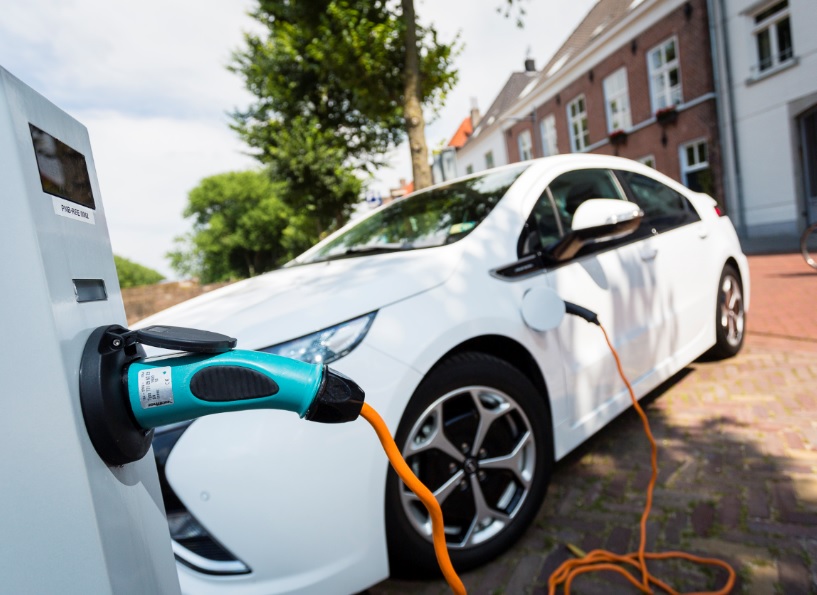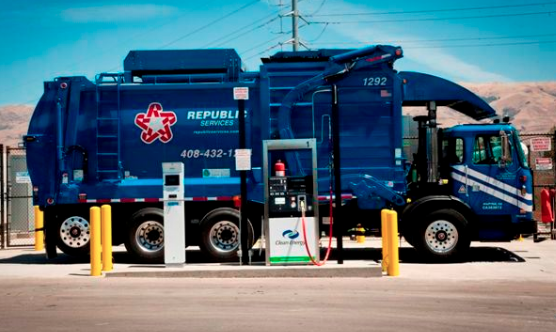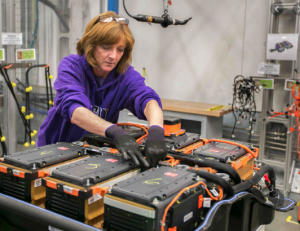Here are 10 trends and developments that are bound to have a big impact on clean transportation and other sectors — including the presidential election, European emissions rules, and what’s next for car sharing and autonomous vehicles.
1. No continuation of federal EV tax credit
 The federal tax credit for purchasers of electric vehicles is ending for automakers selling the highest volumes and hitting their caps on allowable sales — and it appears that won’t be extended. The cap is at 200,000 units sold by brand of battery electric vehicles with a $7,500 tax credit. Tesla and General Motors have already passed that mark, and just had their pleas for extension ignored by the Trump administration and Congress in the new federal budget. Nissan will be next in line, followed by Ford and BMW. Automakers and EV advocates will need to turn to state incentives. The Top five sales states in EV sales during 2018 — California (about 45 percent of total), New York, Washington, Florida, and Texas — have their own state incentives that will have to be tapped into more.
The federal tax credit for purchasers of electric vehicles is ending for automakers selling the highest volumes and hitting their caps on allowable sales — and it appears that won’t be extended. The cap is at 200,000 units sold by brand of battery electric vehicles with a $7,500 tax credit. Tesla and General Motors have already passed that mark, and just had their pleas for extension ignored by the Trump administration and Congress in the new federal budget. Nissan will be next in line, followed by Ford and BMW. Automakers and EV advocates will need to turn to state incentives. The Top five sales states in EV sales during 2018 — California (about 45 percent of total), New York, Washington, Florida, and Texas — have their own state incentives that will have to be tapped into more.
2. Trump campaign clear about environmental and energy issues
The Trump administration continues to campaign for 2020 re-election, regardless of the president’s impeachment. The odds are that the US Senate, with its Republican majority, will not vote to remove Donald Trump from office — making him the third US president after Andrew Johnson and Bill Clinton to be impeached by the House but failing to reach the two thirds (67 votes) needed to be removed from office. Trump says he’s ready to continue on as president, and the Democrats are continuing to wend their way through candidates. For now, Joe Biden is the leading candidate, according to polls taken of regular voters.
As for the policies, Democratic candidates aren’t mentioning specific issues like the EV tax credit or incentives for fleets to acquire alternative fuel vehicles. As for taxing carbon emissions to get businesses to reduce their greenhouse gas emissions, Joe Biden, Pete Buttigieg, Julian Castro, John Delaney, and Andrew Yang, support it. On extending a cap-and-trade program such as the one started years ago in California, only Tom Steyer is endorsing it for now. As for the Trump campaign, you can review the campaign website and see that the administration will continue it’s crusade to gut environmental regulations, softening fuel economy and emissions rules, and denying climate change exists — statements that can be validated and detailed by environmental groups. Here are a few of the Trump 2020 campaign website statements………
“President Trump and his administration acted aggressively to increase exports of energy resources to the global market. This allowed financing for coal and fossil energy projects………. President Trump has approved the infrastructure and provided the resources needed to unleash oil and gas production in the US……… The Trump administration reversed President Obama’s moratorium on new leases for oil and gas development on federal lands………. President Trump rescinded President Obama’s costly Clean Power Plan and instead has proposed the Affordable Clean Energy Rule……… The EPA has rescinded President Obama’s methane emissions rule that would cost American energy developers an estimated $530 million annually……… The EPA is reviewing a rule that if rescinded would relax costly fuel standards and save $340 billion in regulatory costs……… President Trump announced his intent to withdraw the US from the unfair Paris Climate Agreement.”
3. Long-anticipated emission rules starting in Europe
Light-duty vehicle manufacturers will see more stringent emissions standards take effect in Europe in the new year with a phase-in period extending into 2021. Automakers will have to sell a lot more hybrid and electric vehicles in European Union member countries or they’ll pay costly fines, a situation similar to China. Scientists say that about 20 percent of Europe’s carbon dioxide and greenhouse gases come from light-duty vehicles, and heavy-duty trucks add to that emissions share even more. Shareholders worry that profit will be hurt as these green cars can’t be sold at higher prices than conventional gasoline and diesel models, which means they won’t be profitable until battery costs come down. The regulations will eventually cover heavy-duty trucks, albeit with a longer timeline. In Europe, commercial trucks will have to emit 30% less greenhouse gases by 2030. The US will have to continue to wait and see how the Trump administration is ruling on light-duty vehicles and later on medium- and heavy-duty vehicles — though it certainly will be at a less strict standard.
4. Going from NAFTA to USMCA
The House of Representatives voted Dec. 19 in favor of a new trade deal replacing NAFTA. The new United States-Mexico-Canada Agreement (USMCA) was passed by an overwhelming bipartisan vote of 385 to 41, with a large majority of Democrats approving the deal — a day after House Democrats voted to impeach the president. The Senate plans to ratify USMCA next year, potentially after it holds a January trial on whether to remove Trump from office. According to the new USMCA rules, 75 percent of car or auto parts need to have originated in a country partnership. Under NAFTA’s rules, the floor was 62.5 percent. Additionally, 70 percent of a car’s steel and aluminum purchases must be made in North America.
The new rules also require that a certain percentage of vehicles imported duty-free must be made in a place where employees make an average of $16 per hour. But the critical question remains to be seen — if the new agreement will force enough changes to shift production of vehicles from Mexico to the US. While the U.S would likely replace some of its duty-free imports with its own production, it will still need to rely on more expensive imports. It will cost automakers nearly $3 billion over the next ten years, according to budget projections made by the Congressional Budget Office. And it won’t face the reality of globalization of automotive manufacturing and distribution, and that new vehicles sold in the US already display a mix of foreign-made parts and components. As for now, General Motors and Ford support the new USMCA rules, as does the American Automotive Policy Council, which lobbies for Ford, GM and Fiat Chrysler. Labor unions had been pushing for the bill, too, to protect domestic workers.
5. Tesla bucking downward sales slump in China
While new vehicle sales in China — including electric vehicles — continued to see a downward slide in November, Tesla broke that cycle with a 14-fold gain in new-vehicle registrations. Registrations of Tesla vehicles climbed to a five-month high of 5,597 in November, compared with 393 vehicles sold a year earlier. The China-built Model 3s are set to start at about $50,000, slightly cheaper than imported versions. Tesla thinks it can lower that price by 20 percent or more next year as it starts using local components and parts, reducing costs. There’s much at stake for Tesla as China accounts for about half of the world’s electric-vehicle sales — and with the company seeing the country becoming its largest global market after the US. The electric carmaker needs to see another burgeoning market as EV tax incentives will be going away soon in the US for Tesla and other makers.
6. New EVs that are gaining the most interest
In recent weeks following the LA Auto Show and announcements on 2020 product offerings, a few electric vehicle models have been getting much of the attention. One interesting question is will Tesla’s new Cybertruck will cannibalize sales of the upcoming Tesla Model Y crossover SUV………. Electric truck maker Rivian has raised $1.3 billion for the R1T pickup in a new financing round led by T. Rowe Price. Prior investors including Amazon, Ford, and BlackRock participated in the deal. Amazon, of course, will be buying a lot of the trucks………… Ford’s Mustang Mach-E electric SUV was very hot at the LA Auto Show. It will start arriving in late 2020, and Ford will only make 50,000 units globally in the first model year……….. The 2022 Fisker Ocean crossover SUV can be secured with a $250 down payment. It will offer 250 to 300 miles of range and will feature recycled materials from the ocean……… Volvo and its Polestar subsidiary will only be sending out its Polestar 2 electric car to select dealers in the network. It’s so popular that dealers in Illinois are fighting the Polestar Automotive USA’s plans to limit the dealer distributions…………. Watch for battery- and hydrogen-powered commercial trucks and buses to make a splash in 2020.
7. The latest in autonomous vehicle regulations
Autonomous, light-duty trucks can now be used for commercial purposes on public roads in California. The state’s Department of Motor Vehicles announced the proposal this month, which outlines a permitting process for companies wishing to test or deploy driverless trucks for commercial use. The new rule only applies to autonomous vehicles weighing less than 10,001 pounds — Class 1 and 2 trucks that would include minivans, pickup trucks, utility vans, and step vans. This would be ideal for delivery companies………. At the moment, all autonomous vehicles undergoing testing must have a few controls in place, those being steering wheels and backup drivers. General Motors wants to roll out a small fleet of autonomous vehicles that don’t have these two things. The National Highway Traffic Safety Administration says it will have a decision soon on the automaker’s request.
8. Will female CEOs carry over to automakers?
Enterprise Holdings announced earlier this month chief operating officer Chrissy Taylor would take on the role of chief executive in a planned succession. Taylor, the granddaughter of company founder Jack Taylor, will take the wheel on January 1. She’ll replace Pam Nicholson, the No. 23 person on the Fortune Most Powerful Women in business list who had served as CEO of the car rental giant since 2013. They join Hertz president and CEO Kathryn Marinello, making for two of the three US car rental conglomerate chiefs. In the auto industry — US and global — General Motors CEO Mary Barra is the only woman to run one of these companies. For now, it’s still a boys club — although women make up a third of the technology team on Ford’s Mach-E.
9. Car-sharing continues to be a tough business
Daimler and BMW have called it quits on Share Now, its joint car-sharing unit. A low adoption rate was citied. Share Now will exit the North American market and cease operations in London, Brussels and Florence, at the end of February. Another sad story also came this month, that BlueIndy will cease operations four years after the electric-car-sharing program arrived in Indianapolis. Members of the car-sharing network were told by email that financial reasons were behind the closure. The collaboration with the City of Indianapolis will end on May 21, 2020. BlueIndy said in a news release that 11,000 members took about 180,000 rides over the course of four years, but “Indianapolis drivers have been slow to adopt alternative transportation options and car ownership remains extremely high.”
10. Impact of sulfur emission rules on fuel prices
With the International Maritime Organization (IMO) ready to release its regulation on sulfur emissions on January 1, concerns are being raised over the impact on fuel prices and the economics of transportation. The ocean shipping industry accounts for 90 percent of global trade, and the IMO’s international mandate to reduce “bunker fuel” sulfur content in marine fuel oil from 3.5 percent to 0.5 percent is expected to have a major impact. That will go for maritime shipping and trucking.
According to an IMO analysis at Wood Mackenzie, the global refining system is not equipped to produce the volumes of low sulfur fuel needed to power the world’s shipping industry by the time the regulation goes into effect. While there are existing stockpiles of low sulfur fuel available, the consulting firm expects that existing supply will likely not be enough to buffer global reserves until supply eventually catches up with demand. That consumption rate was about 3.5 million barrels a day from the global maritime sector in 2018. The shipping industry can be turning to diesel products instead of bunker fuel as the supply runs out and bunker fuel goes up in price. Higher prices are expected to be carried over to the trucking industry and other segments. That increased demand would bring higher diesel prices globally, having a profound impact on the trucking industry — especially in the US where trucking provides the lion’s share of freight transportation from these ships to buyers.
Changes at GAM reader subscriber list
Green Auto Market has stopped working with its distribution partner, and the subscriber box will be changing. Until that’s done, new subscribers or those with changing email addresses will need to contact the editor at jlesage378@gmail.com to be placed on the new email distribution list.

 Inc., and other refuse companies, in showing the leadership role these companies can make in clean transportation, renewable fuels, and waste-to-energy projects.
Inc., and other refuse companies, in showing the leadership role these companies can make in clean transportation, renewable fuels, and waste-to-energy projects.